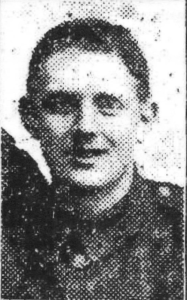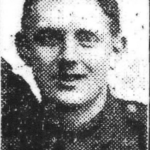
BORN HULL 1893. ENLISTED 28/9/14. SON OF JOHN & ANN WHISKER ABOVE. ONE OF 5 CHILDREN (3 SONS). HE WON THE MILITARY MEDAL KEEPING HIS GUN IN ACTION, UNDER HEAVY FIRE. HIS PHOTOGRAPH APPEARS IN THE HULL DAILY MAIL ON 22ND MARCH 1918. HE WAS ENGAGED.
Hull Pals Memorial Post. L/CPL HARRY WHISKER MM 12/698. Born in 1893, Harry was the youngest of nine children to John and Ann Whisker of 21 Prospect Place, Church Street, Hull. A Sawmill Labourer by trade, he enlisted at Hull City Hall on 28th September 1914 joining the 12th Battalion East Yorkshire Regiment, ‘The Sportsmen’, 3rd Hull Pals. A veteran of Egypt Harry was made Lance Corporal following the ill-fated attack on Serre in November 1916, the last action of the slaughter on the Somme that Summer. He survived Oppy Wood when so many of his comrades fell, but was wounded in the left thigh in November 1917 and injured out of the line. Unfortunately for Harry it wasn’t a ‘Blighty’- the soldiers’ term for a wound that took you out of the war- and he returned to the front line a few days later. Transferring to the 11th Battalion when the 12th was disbanded in February 1918, Harry was pushed up the meet the full onslaught of the German Spring Offensive and was killed in action on 26th March 1918. His body was never recovered and his name is commemorated on the Arras Memorial; he was 24 years old.
Born Hull 1893. Son of John William Whisker (1851-1925) and Ann Hare Shann (1861-1928), of 21 Prospect Place, Church Street, Hull. He had three brothers and five sisters. A Saw Mill Labourer. Described as 5 foot, 11 inches tall, 147 lbs weight, 35-37 inch chest. Enlisted Hull, ON 28/09/1914, aged 21. Trained at Dalton, Ripon and Salisbury Camps. Served with the 11th East Yorkshire Regiment, in Egypt and France. Wounded in the thigh and thumb, on 17/08/1917. Re-joined his unit, on 08/02/1918. Killed in action, on 26/03/1918, aged 24. Awarded the Military Medal (MM), for bravery. Commemorated on the Arras Memorial. His army effects were left to his mother, Ann.
Background. When the German spring offensive opened on 21 March 1918, 31st Division was in reserve, with 10th and 11th EYR Battalions digging trenches in the ‘Army Line’ behind the front. On 23 March the division was sent up to hold off the German attack at St Léger, but 92 Bde remained in reserve at Ervillers, improvising the defences. Ervillers was attacked on the evening of 24 March, the defence being confused by British troops retreating from the forward defences. Two companies of 10th Bn were pushed up to reinforce 11th Bn fighting in the village streets. About midnight a German patrol got into the village, but was captured by 11th Bn’s HQ staff. The following day the 11th Bn was reinforced by 10th Bn Manchester Regiment of 42nd (East Lancashire) Division and their combined fire stopped the German advance. However, events elsewhere meant that the 31st and 42nd Divisions were ordered on the morning of 27 March to retire through Courcelles-le-Comte.
On 27th March 1917, the brigade defended Ayette aerodrome against repeated attacks from 11.20am to 16.30pm, when with both flanks ‘in the air’, the brigade pulled back to the partly-dug ‘Purple Line’ in front of Ayette village. Between 24 and 27 March, 10th EYR Bn had lost 211 officers and men, and was praised “for its exceptional gallantry on March 27” by the Commander in Chief of the BEF, Sir Douglas Haig. During the night, Lt-Col Headlam of 10th Bn led up a composite battalion of troops from the quartermasters’ details of all three battalions to take over part of the Purple Line, and they helped to recover some 18-pounder ammunition from behind enemy lines, which was fired the following day. Although fighting continued elsewhere along the line, 28 March was a quieter day for 92 Bde, and 11th Bn took over some trenches started by 210th Field Company, Royal Engineers, which they continued to dig. The brigade was relieved on 31 March and marched back to billets near Pommier.
